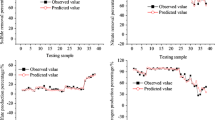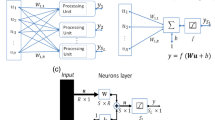Abstract
Artificial neural network and a statistical model have been applied in a laboratory scale trickle bed reactor (TBR) to investigate the SO2 removal efficiency of activated carbon. The performance of artificial neural network (ANN) model has been compared with the statistical model based on central composite experimental design. Two independent variables, which affect the amount of SO2 removal by the liquid phase in the TBR, were selected; namely liquid flow rate and gas flow rate. Amount of SO2 removal was chosen as the dependent variable (target data). A second order statistical model has been considered to show the dependence of the amount of SO2 removal on the operating parameters. A back-propagation ANN has been used to develop a model relating to the amount of SO2 removal. A series of experiments have been conducted on the basis of the statistics-based design of experimental method. It is observed that a neural network architecture having one input layer with two neurons, one hidden layer with three neurons, one output layer with one neuron and an epoch size of 20 gives better prediction. The predictions are more accurate than those obtained from regression models.







Similar content being viewed by others
Abbreviations
- b i :
-
Statistical model coefficients
- U i :
-
Real value of the parameters
- U iav :
-
Average values of the parameters
- U * i :
-
Average value of the independent variables at centre points
- ΔU i :
-
Incremental value of the parameters
- U 1 :
-
Liquid flow rate
- U 2 :
-
Gas flow rate
- X 1 :
-
Coded value of the liquid flow rate
- X 2 :
-
Coded value of the gas flow rate
- ISE:
-
Error square integral
- Yi :
-
ith experimental value of the amount of SO2 removal
- TBR:
-
Trickle bed reactor
- Prob > F :
-
Probability of seeing the observed F value if the null hypothesis is true. Small probability values call for rejection of null hypothesis. The probability equals the proportion of the area under the curve of the F distribution that lie beyond the observed F value. The F distribution itself is determined by the degrees of freedom associated with the variances being compared
- R squared:
-
A measure of the amount of deviation around the mean explained by the model
- Mean squared:
-
Sum of squares divided by DF
- Model F value:
-
A test for comparing model variance with residual variance. If the variances are close to the same the radio will be close to one and it is less likely that any of the factors have a significant effect on the response calculated by model mean square divided by residual mean square
- DF :
-
Degrees of freedom
References
Castellari AT, Haure PM (1995) Experimental study of the periodic operation of a trickle bed reactor. AIChE J 41(6):1593–1597. doi:10.1002/aic.690410624
Coşkun N, Yıldırım T (2003) The effects of training algorithms in MLP network on image classification, vol 2. In: International joint conference on neural networks (IJCNN), Portland, Oregon, USA, pp 1223–1226
Dernuth H, Beale M (1992) Matlab neural network toolbox. The Math Works Inc., Natick, pp 6.2–6.3
Dudukovic MP, Larachi F, And Mills PL (2002) Multiphase catalytic reactors: a perspective on current knowledge and future trends. Catal Rev 44:123–246. doi:10.1081/CR-120001460
Fausett L (1994) Fundamental of neural networks—architectures, algorithms, and applications. Prentice-Hall, Englewood cliffs
Fernandes FAN, Lona LMF (2005) Neural network applications in polymerization processes. Brazilian J Chem Eng 22(03):401–418
Lee KT, Bhatia S, Mohamed AR, Chu KH (2006) Optimizing the specific surface area of fly ash-based sorbents for flue gas desulfurization. Chemosphere 62(1):89–96
MATLAB (2002) Version 6.5.0 help files. Math Works Inc
Montgomery DC (2005) Design and analysis of experiments, 6th edn. Wiley, Hoboken
Nunnari G, Dorling S, Schlink U, Cawley G, Foxall R, Chatterton T (2004) Modelling SO2 concentration at a point with statistical approaches. Environ Modell Softw 19(10):887–905
Rubio JJ, Yu W (2006) A new discrete-time sliding—mode control with time-varying gain and neural identification. Int J Control 79(4):338–438
Rubio JJ, Yu W (2007) Stability analysis of nonlinear system identification vis delayed neural networks. IEEE Trans Circuits Syst II 54(2):161–165
Silveston PL, Harika J (2004) Periodic operation of three-phase catalytic reactors. Can J Chem Eng 82(6):1105–1142
Simpson PK (1990) Artificial neural system—foundation, paradigm, application and implementations. Pergamon Press, New York
Tamura S, Tateishi M (1997) Capabilities of a four-layered feedforward neural network: four layers versus three. IEEE Trans Neural Netw 8:251
Uçan HL (2001) The sorption of sulfur dioxide in a trickle bed reactor with periodic liquid flow and activated carbon bed. MS thesis, Gazi University, Ankara
Uçan HL, Özkan G, Biçer A, Pamuk V (2005) Removal of SO2 in a periodically operating TBR with activated carbon bed. Process Saf Environ Prot 83(B1):47–49
Author information
Authors and Affiliations
Corresponding author
Rights and permissions
About this article
Cite this article
Ozkan, G., Uçan, L. & Ozkan, G. The prediction of SO2 removal using statistical methods and artificial neural network. Neural Comput & Applic 19, 67–75 (2010). https://doi.org/10.1007/s00521-009-0236-4
Received:
Accepted:
Published:
Issue Date:
DOI: https://doi.org/10.1007/s00521-009-0236-4




